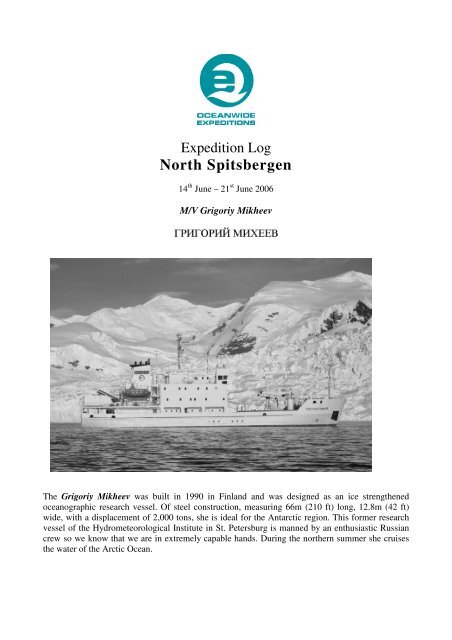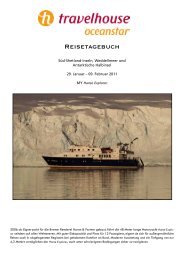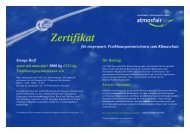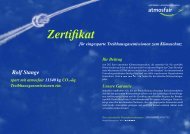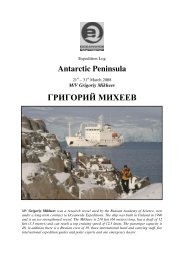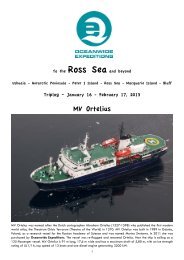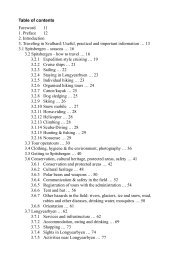North Spitsbergen - Spitzbergen
North Spitsbergen - Spitzbergen
North Spitsbergen - Spitzbergen
You also want an ePaper? Increase the reach of your titles
YUMPU automatically turns print PDFs into web optimized ePapers that Google loves.
14 th June 2006 – LongyearbyenPosition at 16.00: 78°14’ N / 15°39’ WAir temperature: 8°C, westerly breeze, light cloud.Most of us arrived in Svalbard by plane in the afternoon. Boarding of the ship was not until 16.00,which gave everybody a couple of hours to explore the arctic metropolis of Longyearbyen. Manydid a bit of shopping but also visited the small and newly re-build museum in this former miningtown.The ship was lying alongside the pier when we arrived and everybody acquainted themselves withtheir new home for the next seven days. We also met our fellow travellers and our ExpeditionLeader, Rolf Stange, for an introduction to the rest of the staff. The ship set sail at 18.00. Onceunder way we also underwent the compulsory and important lifeboat drill; warm clothes, brightorange life jackets and then up to the lifeboats. Our officers and guides explained the procedure. Wedecided right then that we would better never have to use those life-boats in earnest. Havingsuccessfully completed the drill we settled down for dinner. Many of us enjoyed the views in theearly evening sunshine as we headed out of the massive Isfjord and north on the west side ofmountainous Prins Karls Forland.15 th June 2006 – Kongsfjord – Blomstrandhalvøya, Ny Ålesund, andLiljehöökbreenPosition at 07.00: 78°57’ N / 11°56’ WAir temperature: 4°C, westerly breeze, scattered cloud.The morning wake up call came late in the morning at 7.00. Our good ship Grigoriy Mikheev washeading into Kongsfjorden (Kings Bay) where we were to visit the northern most town in the world:Ny Ǻlesund at 78º.56 N. In the morning however, we made our first landing across the fjord atBlomstandhalvøya, which is also known as Ny London (New London), where the Englishentrepreneur (and brilliant fundraiser) Ernest Mansfield once tried to mine marble. He managed toraise a great sum of money from wealthy investors in Britain by convincing them that he had foundan entire island of marble of the highest quality. He build up the quarry from 1911-1920 but onlysent one shipment of marble back to Britain. When it arrived it had all but crumpled due to minutecracks and change in temperature from the frozen arctic to the more temperate England. Mansfieldwas never again seen in England and hence was never made responsible for the failure. Despite hiseccentricity he was very well liked by local hunters who could always rely on his help if theyneeded supplies or help in any way.After an introduction to Mansfield and the historic site we divided the group in three: one hikinggroup led by Delphine, one group which did not climb all that much led by Troels, and a muchmore leisurely group led by Rolf. All groups had the pleasure of the fantastic view over Kongsfjord.The hikers saw a still white ptarmigan, and along with the two other groups got to enjoy the rare (inSvalbard) Long Tailed Skua flying above us at only a few meters distance. We also experienced ourfirst encounter with inquisitive Svalbard Reindeer.3
During the entire morning Ny Ǻlesund had been visited by a large cruise liner. Luckily for us, theyhad all gone when we arrived after lunch. Ny Ǻlesund is a small community consisting of scientistsfrom all over the world who conduct a variety of research in the fields of atmospheric studies,glaciology, biology etc. A short walk took us into the centre of this historic village passing severalBarnacle Geese. There was also an interesting little museum about the early days of Ny Ålesund,when coal mining determined everything here. Life must have been hard for the miners in theseharsh conditions; work was usually carried out in a kneeling position deep inside the mountain. Weheaded for the lattice mast erected in the early part of the 20 th century by the intrepid explorersAmundsen and Nobile, who tried to reach the <strong>North</strong> Pole by a dirigible airship in 1926 and 1928.The mast is only a few hundred meters from the settlement but our expedition staff insisted thateverybody stayed close to the rifle in case of an unwanted Polar Bear encounter. Luckily there wereno polar bears around this time but a few Svalbard Reindeer was pondering around grazing near themast. Also, a lone Arctic Fox ran around the scientific equipment at the outskirts of town.After dinner we headed north and into the adjacent Kross Fjord/Liliehöök Fjord complex, where weexplored the impressive 7 km wide glacier front of the Lilienhöökbreen (bre = glacier). The weatherhad completely changed from a rather windy Kongsfjord to absolutely calm conditions with a lightsnow fall. Our captain took the ship very close the glacier front giving us the best possible view. Atless than 100 m distance the depth was some 110 m and the glacier front was estimated to be about30 m high. Quite remarkable to think that the ice was somewhere around 140 m thick here! SeveralBearded Seals were also spotted here on ice floes around the glacier front. After this greatexperience the ship headed towards the fjord entrance and to the north for another day of hopefullygreat adventures.16 th June 2006 – Woodfjord, Liefdefjord: Andøyane, Lernerøyane,MonacobreenPosition at 07.30: 79°46’ N / 14°04’ WAir temperature: 4°C, calm, overcast.At 7.30 Rolf once againmade the wake-up callannouncing that we hadmade good speedthroughout the night andalready had arrived in themouth of the Woodfjord onthe <strong>North</strong> West coast of<strong>Spitsbergen</strong>. It was to be aneventful morning as spoutsfrom whales was spotted inthe middle of breakfast.Everybody rushed outsideor to the bridge to see thesegiants of the sea. Indeed, itturned out to be a quiteremarkable sighting of 3-4feeding Fin Whales4
(possibly with a Sei Whale in between) all the way up here at almost 80°N in June!? None of thestaff had ever experienced that before. The captain skilfully and carefully manoeuvred the shiptowards the whales for us all to get a good look.Breakfast was hardly over as Rolf announced the first Polar Bear of the trip on the very islands thatwe were planned to visit: Andøyane (Duck Islands). Everybody got into the zodiacs and we headedtowards the island where the bear was lying sleeping close to the beach. As we approached we sawa small cub lying only a few meters from its mother sleeping. Carefully we approached and got avery good look at these great animals. Eventually the cub woke up and saw us (the mother had longkept a good, yet relaxed, eye on us) and crept closer to its mother. We stayed around for as long asRolf felt appropriate so not to disturb the little family and indeed we left them exactly as we hadmet them. The mornings excursion was not yet over as the zodiacs turned away from the bearinfested island towards another one in this little island group. Here we made a landing on thereddish rocks of the ancient “Old Red” sediment layers, which can be found numerous placesaround the world. The Duck Islands is named appropriately as we saw several Common Eidersaround the island along with some already looted nests. The resident pair of Arctic Skuas hadobviously been on the prowl for a while. Yet another couple of bird species was also seen on theisland. The small Purple Sandpiper was spotted along side a Ringed Plover in one of the smallponds along with one of the favourite bird species of the Svalbard archipelago: The Grey Phalarope.Both the colourful female and the duller male was seen relatively close up. Normally males are thecolourful (and selfish) ones in the animal kingdom, but when it comes to the phalaropes it isopposite. The female runs the show and has the brightest plumage.A fantastic morning was over with both extraordinary sightings of whales and our first two PolarBears.After returning to the ship we headed deeper into the Liefdefjord where we once again took to thezodiacs cruising around a small group of islands called Lernerøyane (Lerner Islands). Here, wemade a short landing with a bit of a walk up the hills to see the fantastic view over the end of thefjord and the great glaciers which terminate here.During ourexcursion the shiprelocated furtherinto the fjord.While most wherezodiac cruising thefew that stayedbehind got a nicelook at a pod ofabout 20 BelugaWhales swimmingin front of the ship.The rest of ushowever, also hada bit of adventureas we sailedbetween the islandsto join the shipagain. This early in the season there is still a bit of fast ice at the head of the fjords as indeed wasthe case here. The zodiacs went icebreaking on a small scale between the islands as we pushed our5
way through to the innermost part of Liefdefjord. Here the ship was parked in the fast ice waitingfor us to be picked up again.All back on board, the captain rammed the fast ice and went a few hundred meters further into thefast ice in front of the magnificent Monaco Glacier. What a spectacle when the ship cuts its waythrough the 50-60 cm thick ice cover! Fast ice normally also means seals and we were not to bedisappointed. Several Bearded Seals lay next to their breathing holes all around. We also so thePolar Bear with the cubs that we had already spotted from the island along with 2-3 other bears faraway in the distance. Dinner was scheduled as a “surprise dinner” and consisted of a BBQ on the aftdeck with complementary entertainment from two of our Russian friends. Belly dancing and Elvisimpressions in the high artic!The ship left the ice again in the evening heading north. It was a spectacular evening with clearskies and great views as we headed into Woodfjord once again. Many enjoyed the snow coveredmountains in the midnight sun on deck or from the bridge. We also saw another Fin Whale, whichwe had a close encounter with. What a fantastic day it had been!17 th June 2006 – Hinlopen Straight: Alkfjellet and TorellnesetPosition at 07.00: 79°40’ N / 18°21’ WAir temperature: 1°C, calm, sunny.In the morning the ship wasstill steaming south throughthe Hinlopen Strait in orderto reach the famous birdcliff Alkfjellet south of theLomfjorden. Here, some100.000 BrünnichsGuillemots nest among thetowering basalt pillars. Thesun was shinning andconditions were fabulousfor the stunning scenery. Itis indeed a fantastic place tozodiac cruise as the water isdeep right up to the sheercliff face and the birds inplaces nest only a fewmeters above sea level. All available cameras were steaming hot in the great light on the cliff andon the myriad of birds in the water, on the rocks and in the air. Not only Brünnichs Guillemots nesthere. The Glaucous Gulls and Kittywakes are also plentiful here, although obviously not in suchgreat numbers. The Glaucous Gull is one of the largest predatory/scavenging birds in the arctic, andhere they live the good life with plenty of prey around. Alkfjellet however, has more than wildlifeto offer. The spectacular basalt columns upon which the birds nest is part of a great intrusion ofbasalt in the otherwise sandstone rock. This intrusion occurred millions of years ago and has nowleft the interface between the two rock types almost knife sharp as a text book example of theincredible forces of nature.6
During lunch we steamed south east towards Torellneset on the south west corner ofNordaustlandet. The area is known to be quite desert like with very little vegetation. However, onebig attraction is to be found here too: Walrus. About 20 mostly male Walrus hauled out on thebeach, which we initially cruised carefully around for a “sea-side” look at these magnificentanimals. Later we landed on the beach at a distance of some 500 m and made a land approach. Notonly where there Walrus on the beach. Two were in the water and exceedingly curious about whaton earth these strange things on land were all about. They approached to within 10-15 m of usstanding on the beach. What a great experience! We then proceeded in orderly fashion along thebeach in order to get a little closer to the hauled out animals that we had already seen from thezodiacs. We got to within 50 meters of them and enjoyed the massive animals occasionallyquarrelling a bit swinging around there large tusks towards each other. The hierarchy is clear insuch a wallow. The biggest males have the say and the privilege of the best spots. Sometimeshowever, it takes a little convincing for the others to realize. While admiring the Walrus, Belugaswhere suddenly spotted a bit off the point where we were standing. First a couple of animals passedrelatively close to the shore and later they were followed by a pod of more than 50! It was indeed avery extraordinary spectacle to see the creamy white backs and well defined spouts within 150meters distance. The staff was equally impressed and honestly stated that they had neverexperienced so many Belugas at this place. Remarkable! Unfortunately, Belugas in Svalbard arenotoriously shy so no attempt was made to approach them by zodiac.We spent around one hour in the presence of the Walrus and Belugas when around half the groupreturned to the ship. The other half went on a little hike up the desert like hills of Torellneset. It is aseries of raised beaches, which is clearly visible as a number of terraces in the landscape. Indeed,they also saw the remaining bones of a whale high in the landscape; a clear indication that it oncewas the shoreline.After dinner Troels lectured on Polar Bears in the dinning room. Interest was great and several othersubjects were touched upon that evening.7
18 th June 2006 – Martensøya and the polar pack icePosition at 07.00: 80°37’ N / 21°25’ WAir temperature: 2°C, light breeze, partly cloudy.In the morning we found ourselvesthe furthest north so far. Over nightthe ship had relocated to theSjuoøyane (Seven Islands) north ofNordaustlandet, which is the secondlargest island in the Svalbardarchipelago. Here we made a landingon Martensøya, which is the easternmost island of this very remote groupof small islands. The landing wasmade somewhat difficult by the largequantities of snow and ice on thecoastline, but a quick scouting trip by Rolf and Delphine during breakfast found a suitable place.Here it is the high arctic climate that rulessupreme. Only a very few months a year arethe islands free of the pack ice and only themost resilient plants such as lichens andmosses can survive here. Desolate as itlooked we still found many traces of animallife. Many tracks of Polar Bear, Arctic Fox,and Reindeer were spotted in the snow andon the beach along with a few SnowBuntings, a pair of Arctic Skuas along with afew Purple Sandpipers. When stepping on theisland, one should think it was completelyvoid of higher life forms, but the tracksproved us wrong. Not many of these animals(the mammals in particular) will spend muchtime here in the summer – indeed they willmost likely starve if they do. The probably came on the pack ice in search of food and stranded herewhen the ice retreated. Some of them are capable to escape while others will have to wait for the iceto return in order to leave.The hikers climbed a small mountaintop on the centre of the island getting a fantastic view overthese the northern most islands in Europe. Some individuals also got involved in activities slightlyless peaceful than what the Svalbard Treaty of 1925 promotes, according to which Svalbard issupposed to be an area completely free of aggressive acts between humans – nevertheless, some ofus ended up with a heavy load of snow in their necks!We returned to the ship in good time before lunch, which gave Rolf the opportunity to give a lectureon ice. Meanwhile the ship headed straight north in the search for the pack ice. In an average yearthe ice will surround the Seven Islands but the ice had already retreated unusually far to the norththis year.The afternoon proceeded northwards as far (almost) as was possible due to the drift ice. Only northof 81° the Mikheev ventured into the denser pack. The sun was still shinning from an almost8
cloudless sky leaving the impressive vast ice fields in a magical bright light. Numerous Polar Bearfootprints were spotted on the ice – some quite old and a few ones indeed very fresh. Despite thebest effort from our expedition staff no bears were actually spotted although conditions seemedperfect. Several seals, Bearded- along with Ringed Seals, were spotted in the water and on the icefloes here and there. Reaching 81°20’N Rolf decided that a zodiac cruise in the great weather andso very far north would be a good idea and most of us went in the zodiacs. Only minutes after thelast zodiac had been loaded fog started to appear in the horizon. Troels and Delphine only justfinished a radio conversation about it before it was on top of us. What an amazing speed with whichit came! None of the less the zodiac cruise proceeded close to the ship in order to soak in the eerieatmosphere of ice and fog. On this cruise the rather rare Pomarine Skua was spotted.It was early evening as we returned to the ship and a nice cup of slightly spiced up hot chocolatewas served on deck by Jan. The captain took the ship further north and not until we had reached81°26’N (923 km from the <strong>North</strong> Pole!) at dinnertime at 19.00 we once again turned southwest. Thefog had in the meantime lifted somewhat and let the sun shine through for a spectacular last view ofthe pack ice.After dinner Delphine lectured on pinnipeds (seals) of the Arctic.9
19 th June 2006 – Raudfjord: Hamiltonbukta, Amsterdamøya: SmeerenburgPosition at 07.30: 80°06’ N / 13°24’ WAir temperature: 4°C, light breeze, overcast.The weather was of the very typicalhigh arctic type with mostlyovercast, light precipitation andpatches of blue sky. All at the sametime of course. We had been quitefar to the north the previous day anddid not arrive in Raudfjord untilaround 10.00 o’clock in themorning. We anchored off the verypicturesque Hamiltonbukta withgreat pointed mountains on the sidesand the relatively small but verydramatic Hamiltonbreen at the end.We started a zodiac cruise on thenorthern side along the beautifulcliffs looking for foxes and bears. Tracks from both species were everywhere to be seen in the snowon the hillside but none of the beasts themselves where to be seen. Foxes and bears are particularlyattracted to this place because of the bird colonies on the mountainsides at the mouth of the fjord.We headed a bit further into the system and landed at small peninsula where we climbed the hill toget the fantastic view over the bay. At the landing site the remains of a reindeer that hat been eatenhere recently was found confirming the notion that foxes and bears have been around the bay veryrecently. The landing was just a little more than half an hour in duration and as we had boarded thezodiacs a Bearded Seal was spotted on an ice floe. They are very weary animals and quite difficultto approach. None of the less we succeeded in getting a good look at it before it disappeared in thewater. We then continued the cruise along the glacier front enjoying the spectacular ice front withall its blue and white shades.During a well-deserved lunch the Mikheev proceeded further to the southwest for our afternoonlanding. Amsterdamøya is a very famous place in Svalbard history as it was the home of the largestwhaling station of the arctic in the 17 th century. Already from the ship the staff had observed a bigbrownish rock, which could in fact be a Walrus hauled out on the beach right close to the whalingstation. Indeed it was, and weapproached this magnificent bull tosome 30 meters. He seemed alltogether ignorant of our presenceand just kept on sleeping andscratching himself respectively.Having spent some time watchingand taking a lot of pictures, thefocus turned on the historic part ofthe landing site. The 17 th centuryDutch blubber pots now surroundedby lots of drift wood originating10
from Siberia allowed only a vague idea about what life might have been like here in the early days.The principal quarry of the whalers was the Greenland or Bowhead Whale, which was hunted to theverge of extinction and has not since recovered in numbers. It is in the family of the Right Whales,as they were the right one to pursue, being a slow-moving animal, which could be approachedclosely. Whalers worked from quite small sailing ships and made voyages of several years. Theactual pursuit and capture of the whales was accomplished from rowing boats carrying about sixmen. Once the boat had managed to approach within a few meters of a gentle giant hand harpoonswere thrown into its body, and when the whale was finally exhausted it was killed with hand lances.The Bowhead whales were towed back to camp, where the oil and the baleen were extracted. Nowonly the few remains of this once important economic society remains. We pondered around the sitetrying to imagine how the place most have been like almost 400 years ago as Rolf told the story ofthe whalers.We were back on the ship in the early evening and before dinner the course was set to go furtherinto the very scenic Smeerenburg Fjord with its massive glaciers. The captain went to great lengthto accommodate our hope to see another glacier front close up. Slowly and carefully he brought theship to within 100 m of the magnificent Smeerenburgbreen ice front while we toasted to a great tripon the bow.20 th June 2006 – Store JonsFjord and Prins Karls Forland: KingoddenPosition at 07.30: 78°21’ N / 12°18’ WAir temperature: 6°C, calm, cloudyDuring the night the ship had sailed steadily southtowards the inevitable final destination thefollowing day. The trip was not over yet however,and in the morning we found ourselves in the mouthof Store Jonsfjord just north of the mighty Isfjord.The Mikheev ventured deep into the majestic fjordwith its massive glaciers coming down themountains on all sides. Smaller bits of ice that hadbeen calved from them floated around the end ofthe fjord making up ideal resting places for beardedseals of which we saw at least five. We even gotreally close to one of them by great navigation byour captain and made a complete circle around thesolid floe on which it was lying. It looked at us afew times but would not leave its floe for anything it seemed – not even a big ship 25 meters away.Leaving the seal where we met it we suddenly discovered a small group of Reindeer on a hillsideclose to the coast. Yet again the captain and crew showed their worth by taking the ship nice andclose to the coast to get a good look at the Reindeer. The ship then headed for the first landing siteof the day on the northern side of St. Jon Fjord. Rolf had picked a spot where we could take a walkon the characteristic tundra of the high arctic. Here there was also a (very) small hut maintained bySysselmanden (Governor of Svalbard) for the one or the other reason. We split up into two groups.Delphine and Troels went a little inland in order to get a closer look at a couple of Reindeers whichwe had spotted from the ship, whereas Rolf took a nice and easy stroll on the tundra near thelanding beach. The walkers soon had to stop walking as they were approached by two exceedingly11
curious young Reindeer. They didn’t quite seem to know what to make of us and circled around uswith inquisitive looks. Eventually they decided that we were not interesting enough and they headeddown into the tiny valley and across to the other side where Rolf’s group were standing enjoyingthe landscape. The two Reindeer also circled that group and hence gave us all a great experience.One can only wonder who was actually watching who…?In the early afternoon while Jan was settling accounts in the bar, the ship steamed out of StoreJonsfjord and towards the southeastern end of Prins Karls Forland. Here we made our final landingat Kingodden, which added a bit to the adventure of the trip since none of the expedition staff hadever been here before. A pioneer last landing on the last day of our Arctic experience.14 th June 2006 – LongyearbyenPosition at 16.00: 78°14’ N / 15°39’ WEverybody left the ship at 9 am and headed to town to do the last shopping before the afternoonflight. The last impressions of this great experience had yet to be really comprehended for most. Itis always sad to leave after a good experience but the memories will live on.12
Species list for <strong>North</strong> <strong>Spitsbergen</strong> aboard Grigoriy Mikheev14-21 June 2006Common Name<strong>North</strong>ern FulmarPink-footed GooseBarnacle GooseCommon EiderLong-tailed DuckGreat black-backed GullRinged PloverPurple SandpiperGrey PhalaropeArctic SkuaLong-tailed SkuaPomarine SkuaGreat SkuaGlaucous GullKittiwakeIvory GullArctic TernBrunnich’s GuillemotBlack GuillemotLittle AukPuffinSnow BuntingRock PtarmiganMAMMALSWalrusBearded SealRinged SealMinke WhaleFin whalePolar BearArctic Fox<strong>Spitsbergen</strong> ReindeerLatin nameFulmarus glacialisAnser brachyrhynchusBranta leucopsisSomateria mollissimaClangula hyemalisLarus marinusCharadrius hiaticulaCalidris maritimaPhalaropus fulicariusStercorarius parasiticusStercorarius longicaudusStercorarius pomarinusStercorarius skuaLarus hyperboreusRissa tridactylaPagophila eburneaSterna paradisaeaUria lomviaCepphus grylleAlle allePuffinus puffinusPlectrophenax nivalisLagopus mutusOdobenus rosmarusErignathus barbatusPhoca hispidaBalaenoptera acutorostrataBalaenoptera physalusUrsus maritimusAlopex lagopusRangifer tarandus platyrhynchus13
1. Blomstrandhalvøya2. Ny Ålesund3. Lilliehöökbreen4. Andøyane5. Lernerøyane6. Monacobreen (BBQ)7. Alkefjellet8. Torellneset9. Martensøya10. Ice / Furthest <strong>North</strong> (81°26’N)11. Hamiltonbukta12. Smeerenburg13. Smeerenburgfjord14. Store Jonsfjord15. Copper Camp16. Prins Karls Forland14
Total length of this trip1014,3 nm / 1878,5 km / 1174 statute milesText by Troels and RolfMaps and photos by Troels and RolfSpieces list and e-mail list by DelphineOceanwide ExpeditionsBellamypark 9NL–4381 CG VlissingenThe NetherlandsTel. +31 118 410 410Fax +31 118 410 417Web www.oceanwide–expeditions.com


